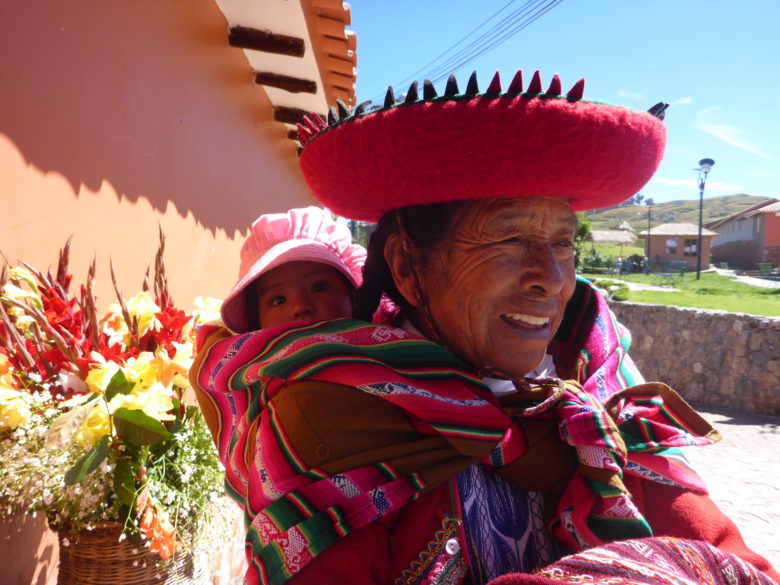Leaving Lima for Cuzco
26 Apr 2016
12:12.18S 77:10.44W. The case of the lost handbag and Lost Portaloos Hotel
We were herded, like a sack load of jungle frogs, into the departure lounge of Lima Airport bound for Cuzco, no room to move but a good opportunity for a chat with Wendy and Peter from Hampshire, who were sharing our flight and the tours for the next few days.
On arrival in the airport a day or so before I had been thrown by the fact we had to run our luggage through the x-ray machines. I thought they only did that before departing on a flight. Anyway muggins here managed to leave her handbag in the x-ray machine. It wasn’t until we met our guide at the exit I realized it. I ran back in to the security area and was stopped from proceeding to where my lonesome bag sat on top of the machine. A tall, (handsome) young Peruvian stood beside me. “What did you forget?” I asked him.
“I have my grandmother coming to stay with me and I completely forgot to collect from the carousel her PORTALOO.” I felt that my embarrassment was secondary to his. We chatted calmly as we both knew the authorities would not particularly want to retain his lost baggage.
A nice chap led me back to retrieve my bag, “what colour is your handbag?” I said orange, Rob said pink, despite the slight confusion my bag and I were united.
Back to the departure lounge and I had just told this story to Wendy and Peter when Peter asked which hotel we were staying in. “Los Portales” I replied and the four of us looked in disbelief at eachother and fell about laughing, “Lost Portaloos”. It shortened the wait.
A very short while later Rob and I found a perfect bar for us, up a steep flight of steps, Nuevo Mundo (new world) was rustic with floor board tables and seats of two heights, low and up you go! Local Draft and bottled beers were numerous and it was a choice from 4.1% to 9+%. With our Machu Picchu experience close we stayed on the low % ones, besides we could try more that way.
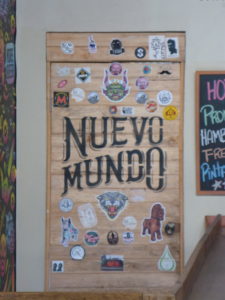
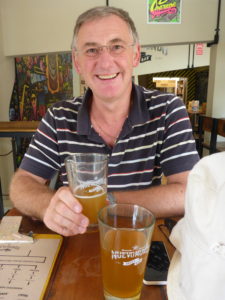
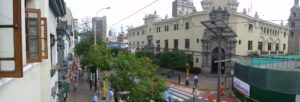
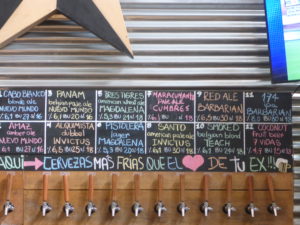
There was a medical reason too, beer is the beer lovers dialytic, containing essential sugars, bubbles and clean water to aid the recovery of our tummies, well not a bad excuse eh.
Opposite our pub was Pussycat Park, well the authorities call it Kennedy Park for some unknown reason but our name is better as it was full with very healthy, chilled out moggies. Hope they are enjoying their lives as unbeknown to them they are being fed on contraceptives, so their numbers will dwindle.
22nd April Mud bricks and Miss Universe
I was catching up on earthquake news in our room when the story of a 6 magnitude quake came out on the BBC World News. They got that wrong I thought. To our horror it was another earthquake, this time 10 miles off the coast and estuary at Bahia and 6 miles under the sea bed. Even closer to our little home town and Zoonie.
It was Emily who told us there was no tsunami announcement. But to date (26th April) we still have no news of her fate.
Our sunny morning in Lima was spent on a photographic errand in Pussycat Park and then a visit to a Kodak shop. A young talented lady helped us solve a technical problem. When we left Zoonie we decided not to take a computer with us so I left the camera computer leads on board. Well of course we really need to upload our photos onto memory stick and onto the blog otherwise I will get way behind and have a large number of photos at risk in one place. We bought from her a universal card reader that will store and display the pics on a computer and TV but now must get another memory card so we can delete them from the cameras and install them on our own computer.
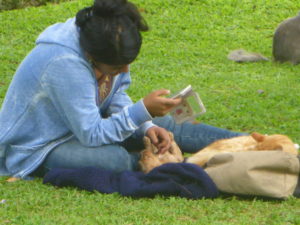
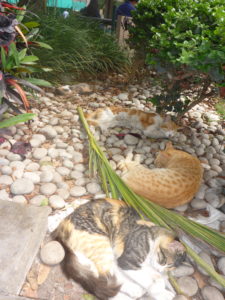
Well you can guess where we had a light lunch before our afternoon guided tour with Miguel. I had a Nuevo Mundo cheese and avocado quesadilla and Rob tucked into a bloody (literally) beef burgher. As he munched merrily through the beef and bacon, blood ran down the lettuce leaf and down his hand, ugh!
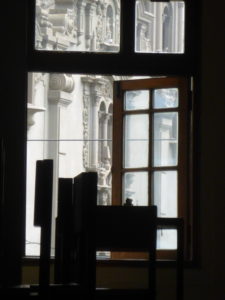

Charismatic Miguel is reckoned to be one of the best guides in Lima whereas his son is an actor, and he confides is one of the worst in Lima. We stopped firstly at the 2000 year old pre-Inca site of Huaca Pucllana where the natives worshiped many gods and the gaps between the millions of hand-made sun dried adobe bricks were to stabilize the building in earthquakes by absorbing movement. How has that knowledge been so broadly ignored by modern builders? Miguel used to ride his BMX over what were then soil slopes of the as yet unexcavated site when he was a boy.
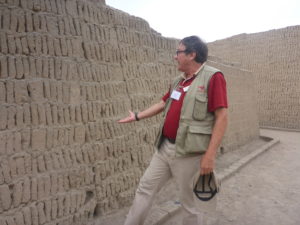
Women then had a tough time. In the event of a terremoto (earth movement or earth quake) one woman would be sacrificed to appease the angry gods. Similarly when a man died his wife was executed and buried with him, because when he wakes up in the next life she would be with him along with his animals and possessions. However, when a woman died her husband was allowed to take another wife, I can see where that was going and why, as a wife, it paid to behave at least overtly.
Miss Universe was sitting in pride of place in the open air restaurant that was part of the temple site surrounded by her guards and guests, I hope she felt better off than her ancestors.
The cathedral was an architectural marvel with careful attention paid to earth tremor risks but also with the advantage of the minimal annual rainfall being only 2 – 3mm. the whole structure was a light flexible build. The pillars are made of bamboo and wattle and sound hollow when tapped, and there are holes in the high, thin wooden dome because it just doesn’t matter with so little rainfall.

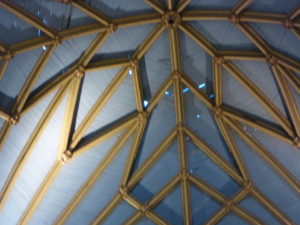
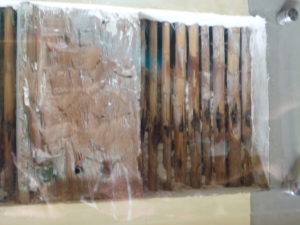
The Incas arrived in the 16th century intent upon destruction. So when the Spanish arrived shortly after, the pre Incas thought that by befriending them they could unite and destroy the Incas. They didn`t reckon on the Spanish, who were not colonialists, bringing with them families etc., but sought only to find gold to take back to their bankrupt king. Soon the pre Incas were destroyed by war with the Spanish and the Incas by disease and warfare with the invaders. At that time the Incas had ruled for just 35 years in Lima and the Spanish then ruled for just over 200years.
Simon Bolivar is remembered throughout Peru and Ecuador for his role in expelling the Spanish, but they had to return to Spain anyway to fight wars in Europe, and no doubt many remained behind since they had inter married and comprise part of today`s multi-cultural society.
There is the mosaic clad tomb of the Spanish leader, Francisco Pizarro which is still as bright and beautiful as the day he was interred. A mural on the wall shows this Spanish leader banishing into his own boats naked Spanish soldiers who refused to fight.
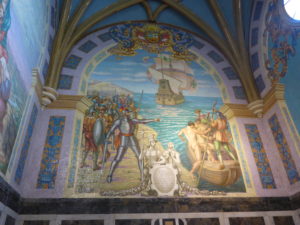
Our final stop of the afternoon was the catacombs of the Dominican monastery of St Francis (of Assisi, therefore Italian in origin) where the monks wear brown. There are reckoned to be 45,000 complete skeletons there at 206 bones per unlucky person makes 9,270,000 bones! Many remain undisturbed in graves containing 8 cadavers laid one on top of eachother. The numerous wells around the crypts are dry and there to absorb earthquake vibration into the air cavities. You can imagine their effectiveness can’t you.
The mini bus took us back through San Isidro, the most desirable part of Lima with its long olive grove running down the middle towards Miraflores, our area just a short distance from the shores of the Atlantic, reminding us of Zoonie a few hundred miles up the coast.
Our hotel in Lima was delightful and in a street full of inviting restaurants and bars, which we would not have time to sample, and a fresh fruit vendor on the corner into the main street.
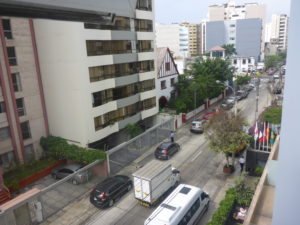
We met Allan and Lorna, friends from Oakham, who will be on Machu Picchu the same morning as us. We had dinner in a Swiss restaurant and caught up with eachothers’ news. Our hotels were close and as we parted I promised to have my pale blue umbrella up in a few days’ time so we could meet again at the vast Inca site.
On our flight to Cuzco the next day we enjoyed a snack of crackers, cake and maize niblets which beat the inflight offering of a toffee on a previous flight!
13:31.19S 71:58.30W Cuzco the 11,000 ft. high Inca Capital
Up the hill from our friendly hotel we found the main square, Plaza de Armas, a comfy walk away in bright sunshine in this city of a half million people. The open sunny square was filled with lovely flower beds, a central statue and fountains, many happy relaxed people all surrounded and watched over by the Andes. The buildings around the square were Hispanic in style. Pedestrians could walk in the shade underneath the first floor and look onto the square through arches. Wooden balconies, richly carved, protruded in front of the first floor (Galician style) and it was in one of these that we ensconced ourselves, backs against the wall and feet on the wooden base of the balustrade for a little beer supping and people watching.
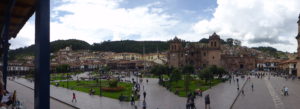
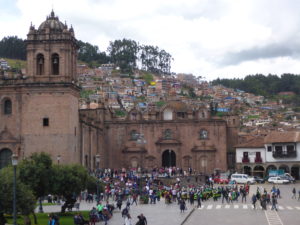
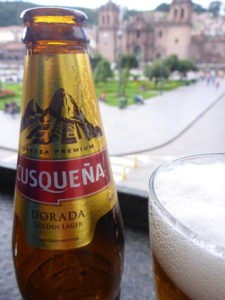
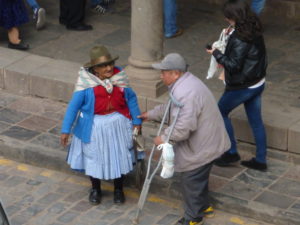
Through this essential bit of research we noticed many were in traditional dress of bright colours, thick full knee length skirts and bright tops, with different style shapely hats depending on which department of Peru they came from. They seemed to be gathering for some event so we went exploring.
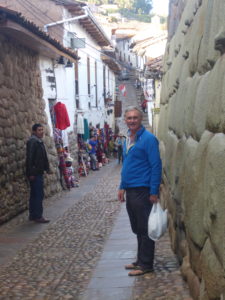
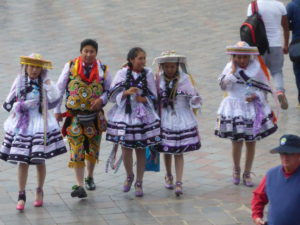

A parade was coming down a road called Plateros into the Plaza, dancing was energetic in the hot sun but progress was slow so we had plenty of time to absorb the scene.
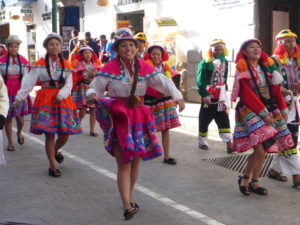
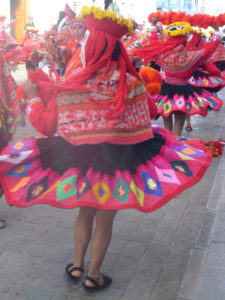
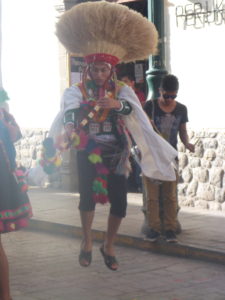
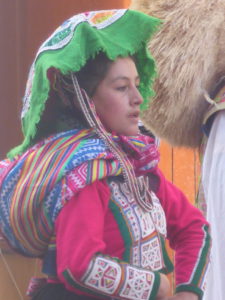
A little girl grabbed my camera, fortunately still looped around my wrist, otherwise I think it would have smashed on the road. I showed her the photo I had taken of her with her mom so she decided to get her own back and clicked away a few random pics of Rob and me and in the process found screens on the camera I had not seen before. After a while her mother said a few assertive words in Quechua and her interest went back to the parade.
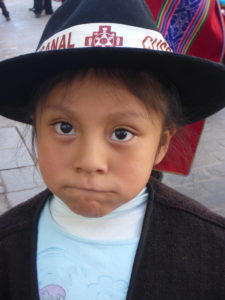
The next day, in equally fine weather we were taken on a tour by Gladys, a well-spoken and engaging lady who would draw us close and away from any sound distraction so she did not have to raise her voice. At Sacsayhuaman we learned great battles had been fought between the Incas and Spanish from the fine Inca fortress. The stones were laid not necessarily in straight lines but without mortar or a gap wide enough for a human hair. Inside the limestone blocks a system of nodes and recesses locked into eachother for strength and walls were sloped and doorways trapezoid in shape to prevent earthquake damage.
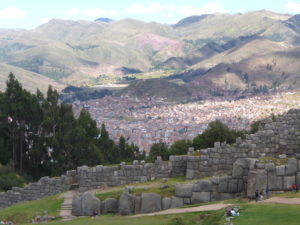
The vast central area was for military activities and in the temple the sun was worshiped by his son the Inca and all his people.
The Incas loved threes and their deities were in threes. The condor, the anaconda and the puma being one and thunder, electricity and lightning bolts was another. The original town was developed in the shape of a puma and at the sacred sight of Tambo Machay the three springs of water were channeled over dressed stone as a place of worship as water was essential to them.
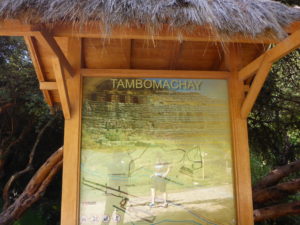
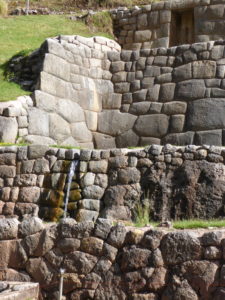
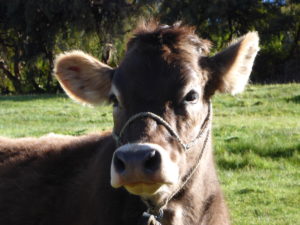
The Inca empire extended north almost as far as Bahia, south into Chile and from the coast across the Andes and into the Amazonian jungle. To move goods from these areas to other areas runners were used who knew their area and would meet the next runner at the foot of the Andes since the demands of the terrain were best undertaken by a local runner. Many rest areas or puca pucaras were established so they could recover. Now these areas are used by families for recreation and picnics and we saw plenty enjoying themselves.
Our last stop was at the Cathedral of Santo Domingo in town. It was built over an Inca Temple reduced to ruins by the Spanish. The difference in quality of the stonework reflected the time and skilled care taken by the Incas compared to the rush job of the most recent interlopers.
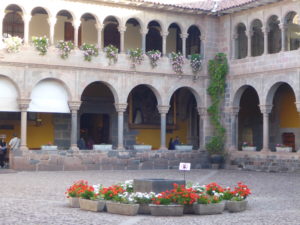
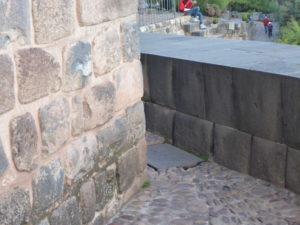
In the evening we had a chica pizza, the smallest, with a bowl of soup with cheese while a talented group played typical Andean music on panpipes, guitar and drums. The restaurant was rustic beyond rustic, a real old adobe terraced room with a pizza oven at the front and kitchen at the back. Walls adorned with farming implements, flat irons and old radiograms and record players, just like in rural English inns.
25th April Machu Picchu minus two!
Our full day excursion the next day started with a bang, literally. Just half an hour out onto the road to Chincheros village through the Sacred Valley and approaching a bend `Bang!` a red car sped around the bend overtaking a bus and collided with our offside. Fortunately it was a right bend, a left one and we may have not been able to pull up before meeting the edge of the road. As it was we were tucked half off the road against a protective hillside.
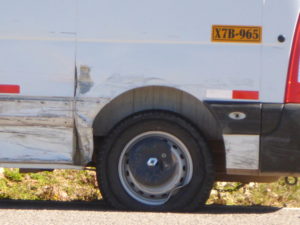
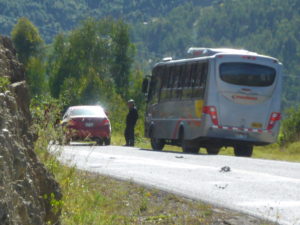

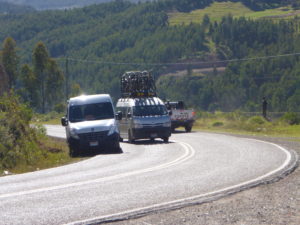
The police arrived, followed by a replacement van and off we went again unscathed. Our tour company in the UK and the agents out here both contacted us to see we were ok. I advised them our driver was in no way responsible for the collision as his road position was correct and his previous driving was to a high standard.
At Chincheros village we admired the wide agricultural terraces of the Incas which we could see in some places extended right to the top of the mountains and then had the pleasure of being entertained in a ladies workshop where the entire process of washing and dyeing, spinning and weaving wool into a vast colourful array of items took place. Guinea pigs (cuy) are kept by the fire in a run in readiness for the pot. Sorry to the sensitive amongst you but I did keep it short and we are visitors and thus non-judgemental.
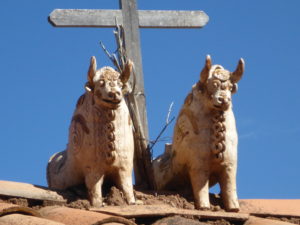
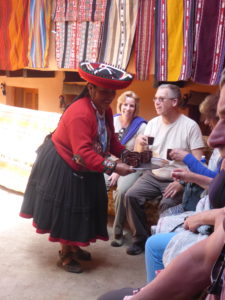
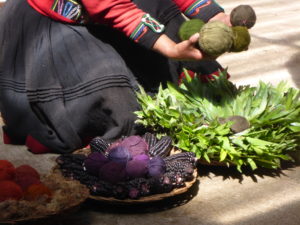
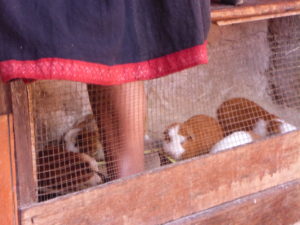
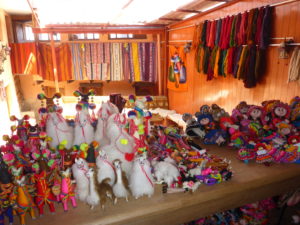
There is a beautiful plateau nearby covered in a patchwork quilt of different coloured fields which have just been bought by the government as the site has been designated for the new airport. Gladys explained that the present airport was built on what was once agricultural land and is now surrounded by buildings and modern Cuzco. We wondered how much of the work would be given to the locals and just how much such a major activity will threaten the traditional way of life.

There is a living Inca Town called Ollantaytambo which is close to the railway station from which folk can take the train to Machu Picchu up one valley. There are two other valley entrances here so it was a major strategic point for the Incas. We SLOWLY scaled the precise and tidy terraces to the incomplete sun temple at the top. This is as far as the Spanish reached before they were led away down one of the other valleys and so never discovered MP. Standing, gasping at the top we could see the grain stores much higher than us and clinging on to the mountain side, where the cool, dry atmosphere would preserve the grain for many years.
On one of the ancient terraces a crop of quinoa was ripening under the sun. Now so popular in the health food industry it is not hard to imagine a future for the cultivation of quinoa on a grand scale on these terraces once again.
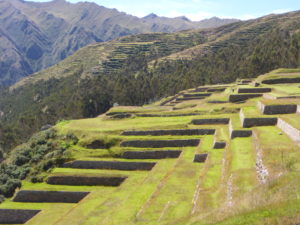
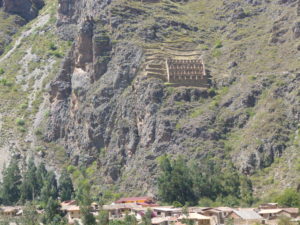
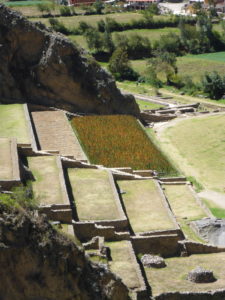
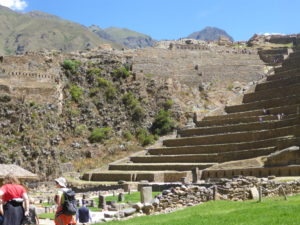
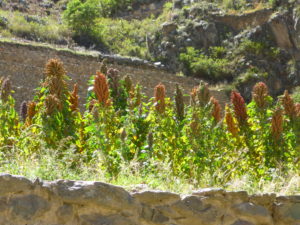
On another hillside the quarry they used was still visible and the final ramp up to the temple floor was at our feet. The massive blocks of stone were moved using ramps and on tree trunk rollers pulled using rope made from alpaca hide. Incredible. On the way down my hat decided to take flight and I was just about to gate vault up onto the shoulder high terrace to retrieve it when not only a tourist but a guide volunteered to save me the bother. It pays to be old sometimes.
Along the final part of our journey we drove parallel with the brown and fast moving Urubamba River which also flows into the Amazon. Then we stopped at a beautiful hotel where the emphasis was on an outdoor life. Amidst lush gardens full of flowers, there were even flowers in the fountains! Guests lounged on the garden terraces in plump easy chairs reading papers and drinking. Around the back was a vast covered dining area with a buffet laid along three sides on tables and a family of llama nonchalantly grazing. That is until a young lady tried to sneak up on the suckling baby for a pat and photo.
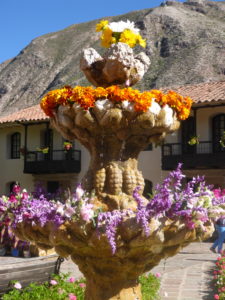
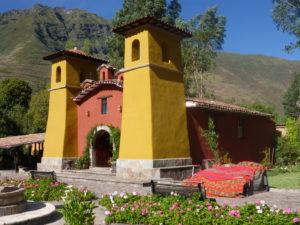
Well he was having none of it, he didn’t like having his lunchtime drink interrupted, so he started chasing her and butting whatever part he could reach as she beat a hasty screaming retreat. Very funny.
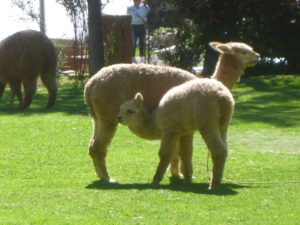
That evening I could not resist trying the Urubamba River trout and very tasty it was too. Rob had alpaca “Just like beef” and the couple next door received a dish of cuy (guinea pig) which looked as if it had strayed into the kitchen only to get a roasting while trying to run away. The young lady was busy taking pics while her poor sensitive, small furry animal loving boyfriend looked as if he was about to either throw up or faint, or both. The dish was returned to the kitchen untouched.
Today, 26th April, MP day minus 1. Update on the tummy situation, Rob is back on the tablets and I`m staying on them at least until MP is conquered, such confidence!
At the Museo of the Qoricancha site, the site which we visited the day before yesterday with Gladys, we learned that the Incas were talented surgeons and 65% of brain operations were successful. Some of the skulls we saw showed considerable re-growth around the holes. We were also pleased to see that over the past few weeks we have tasted many of the historical and present day foods.
The Museo Historico Regional, in the home of half Inca half Spanish Garcilaso de la Vega Gomez Suarez de Figueroa (phew) starts with a salutary warning about climate change and our part in it. They warned of the terminal effect of over exploitation of natural resources, pollution, deforestation and destruction of ecosystems. We see this awareness in many of the places we visit and on the news all the time.
It is a beautiful house, bigger but not untypical of the colonial Spanish homes with their open air courtyard surrounded by a gallery above a lower corridor. I tiptoed through one room so as not to wake the attendant.
Remember the deity of the puma etc? Well the word for Puma comes from the Peruvian Quechua word pumayna meaning powerful as a lion and its image is used throughout their artwork.
Metals were of religious, military and domestic importance, not monetary. They must have cried when the Spanish melted down 580,000 pesos of good gold into 215,000 marks using solid gold objects of the finest quality and greatest religious importance. 12 perfect, life-size figures of women cast in solid gold and dressed in fine clothes were not only worshiped but spoken to as if they were living friends. Well they went back to the Spanish coffers.
Remember also the legend of St James, patron saint of Spain and buried at Santiago de Compostela in Galicia? Well he had a terrible temper didn`t he, which antagonised Herod who allegedly had him beheaded for it. As far as the Incas were concerned he was the perfect human incarnation of thunder in their thunder/electricity/lightning bolt trilogy, so they adopted him. Trouble was he was also very important to the Spanish and as the latter was set on destroying the former they couldn`t both have him.
At one battle he is said to have intervened amongst the troops of Francis Pizarro and spurred them to victory and at another battle St James appeared (possibly represented by a Spaniard on a white horse festooned with decorations) to the Inca soldiers and frightened them to the degree they all fled and escaped the Spanish.
In that fascinating museum I also learned that the chica beer we had drunk with the Kichwa natives in Ecuador was invented by the Incas and Pisco, a wine made from the Quebranta grape and is utterly yummy when made into Pisco Sour, a bit like mojito, actually came with the Spanish from the Canaries in the 16th century.
Contrary to my thinking that the Inca empire ended in 1535, a rebellion against the Spanish started in 1780 when the Chief Justice was murdered and the Inca Tupaq Amaru planned a siege of the Spanish in Cuzco, a spy betrayed him and he was executed with his wife and family and war leaders in the main square, Plaza de Armas. Now known as the Square of Tears.
The martyrdom of course fueled the rebellion which spread throughout South America and called for the final expulsion of the Spanish. They also called for the restoration of the Inca Empire with the descendants of the aristocracy its leaders and a complete overhaul of the economic structure. The new institution called for the abolition of `mita`, compulsory work, elimination of large farms, returning them to family units as they are today and the abolition of custom and land taxes and the introduction of free trade. All sounds familiar doesn`t it!
